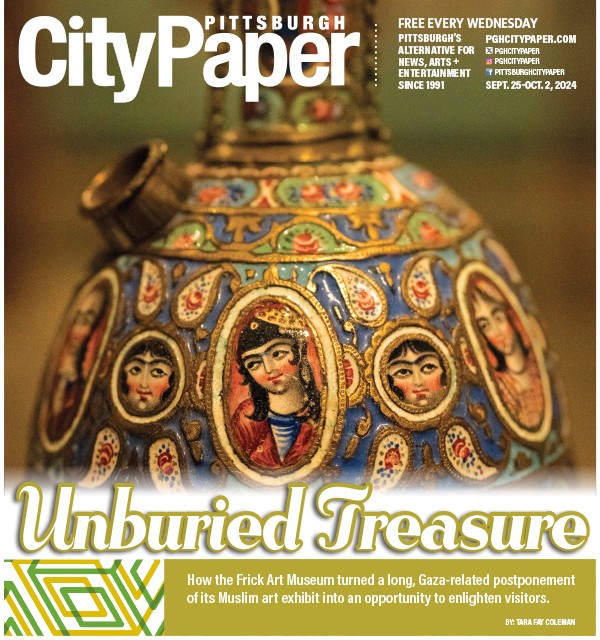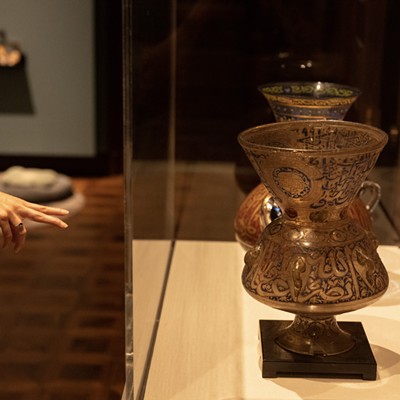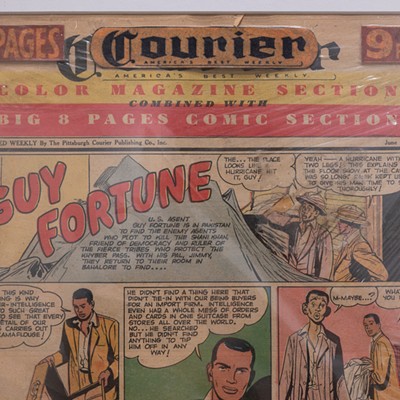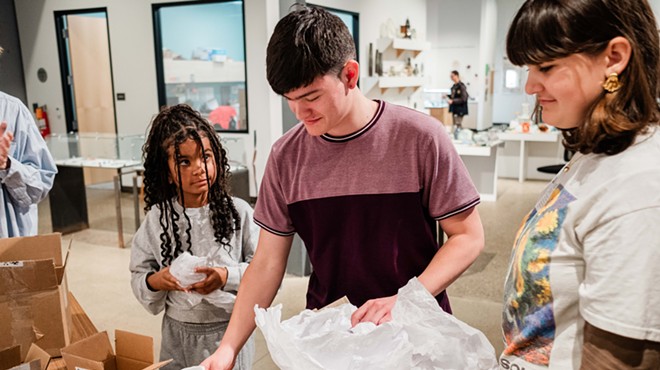King Coal offers a humanizing look at industrial communities in decline
[
{
"name": "Local Action Unit",
"component": "24929589",
"insertPoint": "3",
"requiredCountToDisplay": "1"
}
]
Communities dependent on the coal industry have, for decades, been the subject of political debate — used by the right as examples of a blue-collar American way of life in need of rejuvenation, and by the left as victims of exploitation by villainous companies putting profits about people and the environment. Then there are the labor movements that draw inspiration from the violent conflicts between once-poor, struggling miners and strikebreakers hired to quell any ideas about fair wages and safe working conditions.
What often gets lost in all the symbolic discourse are the actual people who still reside and try to carve out a living in these communities, something filmmaker Elaine McMillion Sheldon seeks to remedy with her artful documentary King Coal.
Shot between 2019 and 2022 in coal communities across the United States — including in Kentucky, Tennessee, Virginia, Ohio, Pennsylvania, North Carolina, and McMillion Sheldon’s home state of West Virginia — the film sets out to humanize an industry on the decline.
Some of the footage was captured in and around Pittsburgh, including at the Carnegie Museum of Natural History, at the Bituminous King Coal Show in Carmichaels, Pa., and in the Laurel Highlands.
The film has made its way to Pittsburgh, another place that has seen its share of heartache over the loss of an industry that, before its gradual departure, kept the city running. Audiences can catch King Coal at the Lindsay Theater and Cultural Center in Sewickley, where, from Fri., Sept. 1-Thu., Sept. 14, it will screen as part of the venue’s Back to School documentary series.
This is no outsider perspective on the subject — McMillion Sheldon, who grew up in Logan County, W. Va., comes from four generations of coal miners, and her brother still works in the industry.
“So I grew up around people that took this job for a living and have seen it decline over the course of my life,” says McMillion Sheldon, who now lives in Knoxville, Tenn. “When we talk about coal, we often talk about economics and politics and the environment, and those are all worthy topics. But something that I think is kind of missing in the conversation, when we talk about transitioning, is that coal has been the cornerstone for many communities, and gives a sense of belonging, and identity, and togetherness.”
The title comes from the Bituminous Coal Queen pageant that takes place every year in Pennsylvania’s Greene County, an area still reliant on mining.
“And so, the film really looks at coal-related rituals that still go on in the coal fields, like a beauty pageant in southwestern Pennsylvania, and other things that people do to come together, and then ask the question of, who are we without a king? If this is no longer our story, what is our story moving forward?” she says.
As opposed to doing a straightforward documentary complete with the usual talking heads and bleak imagery, McMillion Sheldon enlisted two young female actors to dance against the backdrop of America’s coal towns, and incorporated “elements of fable and magical realism.” This serves to frame footage of coal communities as they are now, with breathtaking imagery of a world defined by floating barges, railways, and earth-ripping machines, as well as of young people working, going to school, and trying to imagine a future in the place where they grew up.
By using this approach, McMillion Sheldon believes the film avoids taking sides. It also differs from Coal's Deadly Dust, a more traditional coal-focused documentary McMillion Sheldon about black lung. Shot as part of a collaboration between PBS Frontline and NPR, the film was nominated for a Peabody Award, a Writers Guild of America Award, and two Emmys.
“[King Coal] really kind of stretched the rules of the nonfiction form to tell a story about the psyche, rather than one that was just something you could observe,” says McMillion Sheldon. “And so I think the way we told the story appeals to a lot of people and opens them up to maybe realizing, ‘I don't know, the full story of this region that's been depicted in certain ways.’ And then also, the universality of just, we're all from a place and that place has a story, and in order for cultures to survive and thrive, they have to keep changing to stay alive.”
That change, Sheldon believes, has been difficult for people in coal communities due to how few long-term solutions have been offered to them.
“In my home state of West Virginia alone, you're seeing a lot more movement to make more sustainable industries come in,” she says. “I think the problem, though, is that we're not seeing any large-scale replacements. Coal was such a huge employer, and it was high wages for lower education. … And the transitional industries are often lower pay, or they require a certain level of training. And so, it's just taking a lot of time, I think, for people to want to give up something that they can make $65,000 or $70,000 straight out of high school. I think there's just been a lot of short-term solutions. And what we need to be doing is thinking long term, what do we want this region to provide?”
She adds that, unless something changes, places like West Virginia will lose young people to towns and cities that offer more job security.
Since the film premiered in January at the Sundance Film Festival in Park City, Utah (itself a copper mining town, as McMillion Sheldon points out), it has shown at nearly 30 film festivals all across the U.S. Harris Theater in Downtown Pittsburgh also recently hosted a one-night screening of the film.
“So the response has been really incredible, both locally and afar,” says McMillion Sheldon. “And we were really careful in the film to not to sort of toe the line, to tell the truth, and to be honest, and to ask challenging questions, but to not condemn the past and have a forward-facing view where we all can move forward in a way that's more equitable for people.”
She believes the film will resonate with Pittsburgh audiences, not only because of the parallels between the coal and steel industries but because of how these places are quite literally tied to each other, pointing out how the coal seam under West Virginia extends into southwestern Pennsylvania.
“So I think our stories are very connected,” she says. “But beyond just industry, I think it’s one of identity and reinvention. And Pittsburgh went on this journey of reinvention, and people have been left behind in that conversation. … I think there's a strong identity, obviously, with being a steel worker the same way there is with being a coal miner, and there's generations of families that derive a sort of purpose from that. So I think it's gonna be a very relevant story.”
King Coal. Showtimes vary. Fri., Sept. 1-Thu., Sept. 14. Lindsay Theater and Cultural Center. 418 Walnut St., Sewickley. $8.75-11. thelindsaytheater.org
What often gets lost in all the symbolic discourse are the actual people who still reside and try to carve out a living in these communities, something filmmaker Elaine McMillion Sheldon seeks to remedy with her artful documentary King Coal.
Shot between 2019 and 2022 in coal communities across the United States — including in Kentucky, Tennessee, Virginia, Ohio, Pennsylvania, North Carolina, and McMillion Sheldon’s home state of West Virginia — the film sets out to humanize an industry on the decline.
Some of the footage was captured in and around Pittsburgh, including at the Carnegie Museum of Natural History, at the Bituminous King Coal Show in Carmichaels, Pa., and in the Laurel Highlands.
The film has made its way to Pittsburgh, another place that has seen its share of heartache over the loss of an industry that, before its gradual departure, kept the city running. Audiences can catch King Coal at the Lindsay Theater and Cultural Center in Sewickley, where, from Fri., Sept. 1-Thu., Sept. 14, it will screen as part of the venue’s Back to School documentary series.
This is no outsider perspective on the subject — McMillion Sheldon, who grew up in Logan County, W. Va., comes from four generations of coal miners, and her brother still works in the industry.
“So I grew up around people that took this job for a living and have seen it decline over the course of my life,” says McMillion Sheldon, who now lives in Knoxville, Tenn. “When we talk about coal, we often talk about economics and politics and the environment, and those are all worthy topics. But something that I think is kind of missing in the conversation, when we talk about transitioning, is that coal has been the cornerstone for many communities, and gives a sense of belonging, and identity, and togetherness.”
The title comes from the Bituminous Coal Queen pageant that takes place every year in Pennsylvania’s Greene County, an area still reliant on mining.
“And so, the film really looks at coal-related rituals that still go on in the coal fields, like a beauty pageant in southwestern Pennsylvania, and other things that people do to come together, and then ask the question of, who are we without a king? If this is no longer our story, what is our story moving forward?” she says.
As opposed to doing a straightforward documentary complete with the usual talking heads and bleak imagery, McMillion Sheldon enlisted two young female actors to dance against the backdrop of America’s coal towns, and incorporated “elements of fable and magical realism.” This serves to frame footage of coal communities as they are now, with breathtaking imagery of a world defined by floating barges, railways, and earth-ripping machines, as well as of young people working, going to school, and trying to imagine a future in the place where they grew up.
By using this approach, McMillion Sheldon believes the film avoids taking sides. It also differs from Coal's Deadly Dust, a more traditional coal-focused documentary McMillion Sheldon about black lung. Shot as part of a collaboration between PBS Frontline and NPR, the film was nominated for a Peabody Award, a Writers Guild of America Award, and two Emmys.
“[King Coal] really kind of stretched the rules of the nonfiction form to tell a story about the psyche, rather than one that was just something you could observe,” says McMillion Sheldon. “And so I think the way we told the story appeals to a lot of people and opens them up to maybe realizing, ‘I don't know, the full story of this region that's been depicted in certain ways.’ And then also, the universality of just, we're all from a place and that place has a story, and in order for cultures to survive and thrive, they have to keep changing to stay alive.”
That change, Sheldon believes, has been difficult for people in coal communities due to how few long-term solutions have been offered to them.
“In my home state of West Virginia alone, you're seeing a lot more movement to make more sustainable industries come in,” she says. “I think the problem, though, is that we're not seeing any large-scale replacements. Coal was such a huge employer, and it was high wages for lower education. … And the transitional industries are often lower pay, or they require a certain level of training. And so, it's just taking a lot of time, I think, for people to want to give up something that they can make $65,000 or $70,000 straight out of high school. I think there's just been a lot of short-term solutions. And what we need to be doing is thinking long term, what do we want this region to provide?”
She adds that, unless something changes, places like West Virginia will lose young people to towns and cities that offer more job security.
Since the film premiered in January at the Sundance Film Festival in Park City, Utah (itself a copper mining town, as McMillion Sheldon points out), it has shown at nearly 30 film festivals all across the U.S. Harris Theater in Downtown Pittsburgh also recently hosted a one-night screening of the film.
“So the response has been really incredible, both locally and afar,” says McMillion Sheldon. “And we were really careful in the film to not to sort of toe the line, to tell the truth, and to be honest, and to ask challenging questions, but to not condemn the past and have a forward-facing view where we all can move forward in a way that's more equitable for people.”
She believes the film will resonate with Pittsburgh audiences, not only because of the parallels between the coal and steel industries but because of how these places are quite literally tied to each other, pointing out how the coal seam under West Virginia extends into southwestern Pennsylvania.
“So I think our stories are very connected,” she says. “But beyond just industry, I think it’s one of identity and reinvention. And Pittsburgh went on this journey of reinvention, and people have been left behind in that conversation. … I think there's a strong identity, obviously, with being a steel worker the same way there is with being a coal miner, and there's generations of families that derive a sort of purpose from that. So I think it's gonna be a very relevant story.”
King Coal. Showtimes vary. Fri., Sept. 1-Thu., Sept. 14. Lindsay Theater and Cultural Center. 418 Walnut St., Sewickley. $8.75-11. thelindsaytheater.org


















